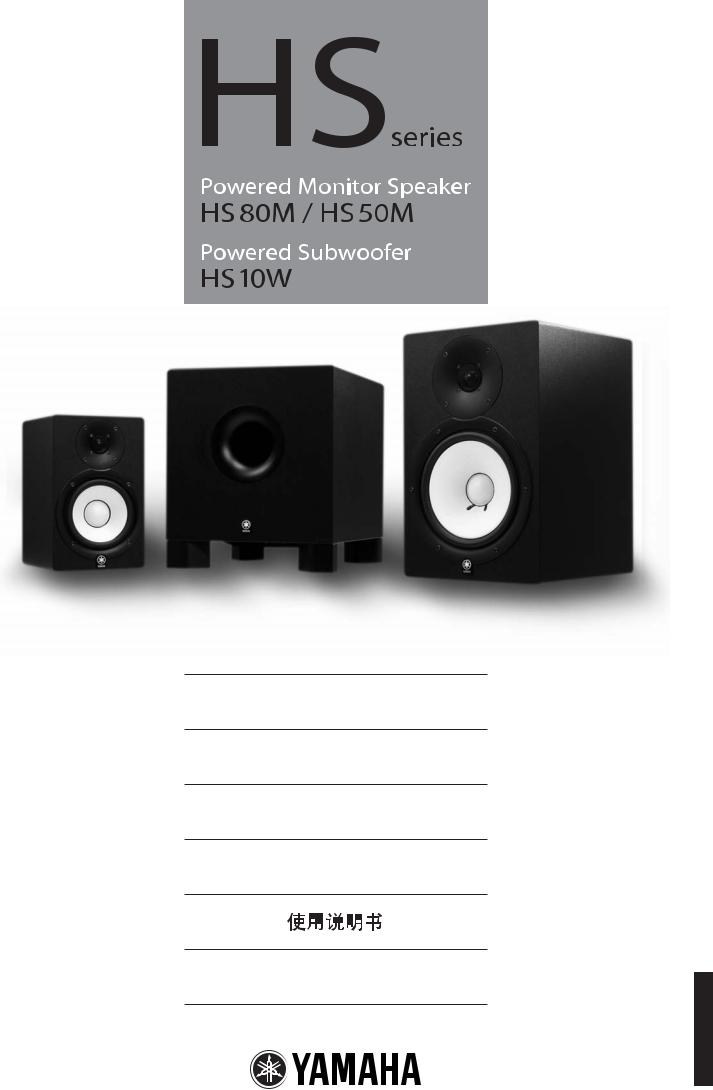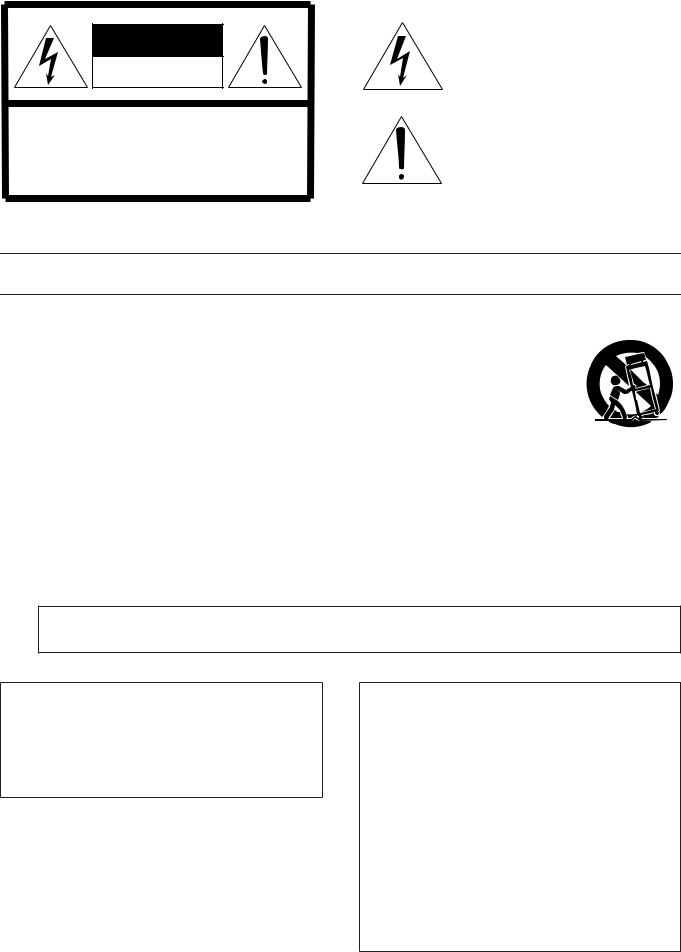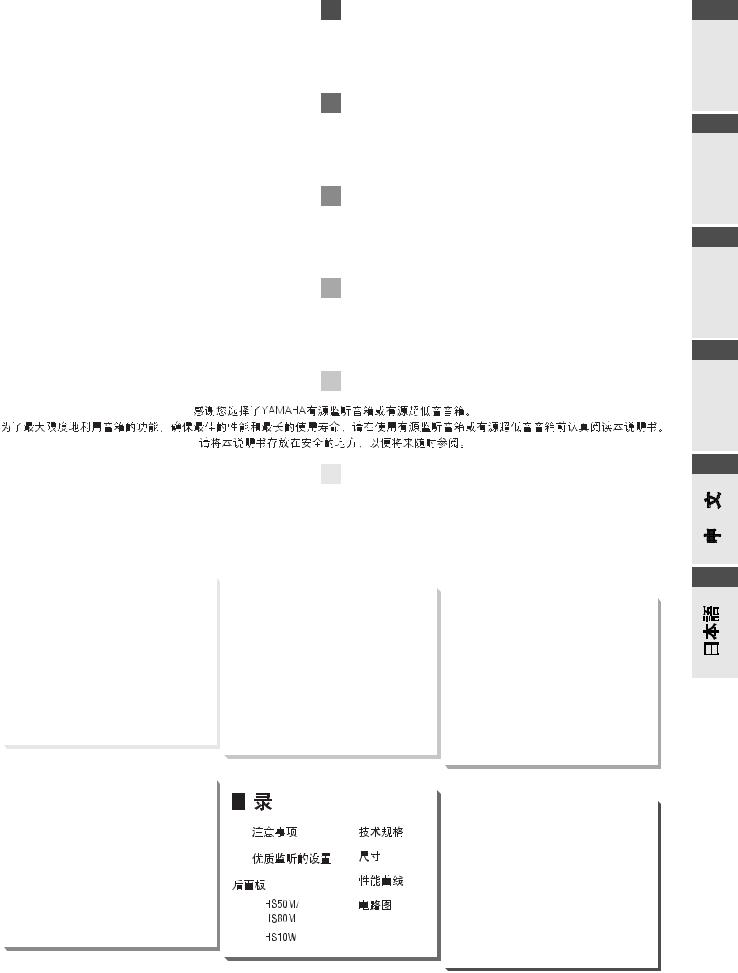Yamaha HS 80M User Manual

Powered Near-field Reference Monitors & Subwoofer
OWNER’S MANUAL
BEDIENUNGSANLEITUNG
MODE D’EMPLOI
MANUAL DE INSTRUCCIONES
EN
DE
FR
ES
ZH
JA

C A U T I O N
RISK OF ELECTRIC SHOCK
DO NOT OPEN
CAUTION: TO REDUCE THE RISK OF ELECTRIC SHOCK, DO NOT REMOVE COVER (OR BACK). NO USER-SERVICEABLE PARTS INSIDE. REFER SERVICING TO QUALIFIED SERVICE PERSONNEL.
The above warning is located on the rear of the unit.
Explanation of Graphical Symbols
The lightning flash with arrowhead symbol within an equilateral triangle is intended to alert the user to the presence of uninsulated “dangerous voltage” within the product’s enclosure that may be of sufficient magnitude to constitute a risk of electric shock to persons.
The exclamation point within an equilateral triangle is intended to alert the user to the presence of important operating and maintenance (servicing) instructions in the literature accompanying the product.
IMPORTANT SAFETY INSTRUCTIONS
1Read these instructions.
2Keep these instructions.
3Heed all warnings.
4Follow all instructions.
5Do not use this apparatus near water.
6Clean only with dry cloth.
7Do not block any ventilation openings. Install in accordance with the manufacturer’s instructions.
8Do not install near any heat sources such as radiators, heat registers, stoves, or other apparatus (including amplifiers) that produce heat.
9Do not defeat the safety purpose of the polarized or grounding-type plug. A polarized plug has two blades with one wider than the other. A grounding type plug has two blades and a third grounding prong. The wide blade or the third prong are provided for your safety. If the provided plug does not fit into your outlet, consult an electrician for replacement of the obsolete outlet.
10Protect the power cord from being walked on or pinched particularly at plugs, convenience receptacles, and the point where they exit from the apparatus.
11Only use attachments/accessories specified by the manufacturer.
12Use only with the cart, stand, tripod, bracket, or table specified
by the manufacturer, or sold with the apparatus. When a cart is used, use caution when moving the cart/apparatus combination to avoid injury from tip-over.
13Unplug this apparatus during
lightning storms or when unused for long periods of time.
14Refer all servicing to qualified service personnel. Servicing is required when the apparatus has been damaged in any way, such as power-supply cord or plug is damaged, liquid has been spilled or objects have fallen into the apparatus, the apparatus has been exposed to rain or moisture, does not operate normally, or has been dropped.
WARNING
TO REDUCE THE RISK OF FIRE OR ELECTRIC SHOCK, DO NOT EXPOSE THIS APPARATUS TO RAIN OR MOISTURE.
(98-6500)
IMPORTANT
Please record the serial number of this unit in the space below. Model:
Serial No.:
The serial number is located on the bottom or rear of the unit. Retain this Owner's Manual in a safe place for future reference.
IMPORTANT NOTICE FOR THE UNITED KINGDOM
Connecting the Plug and Cord
WARNING: THIS APPARATUS MUST BE EARTHED IMPORTANT. The wires in this mains lead are coloured in accordance with the following code:
GREEN-AND-YELLOW : EARTH
BLUE |
: |
NEUTRAL |
BROWN |
: |
LIVE |
As the colours of the wires in the mains lead of this apparatus may not correspond with the coloured markings identifying the terminals in your plug proceed as follows:
The wire which is coloured GREEN-and-YELLOW must be connected to the terminal in the plug which is marked by the letter E or by the safety earth symbol  or colored GREEN or GREEN- and-YELLOW.
or colored GREEN or GREEN- and-YELLOW.
The wire which is coloured BLUE must be connected to the terminal which is marked with the letter N or coloured BLACK.
The wire which is coloured BROWN must be connected to the terminal which is marked with the letter L or coloured RED.
• This applies only to products distributed by Yamaha-Kemble Music (U.K.) Ltd.(3 wires)

Thank you for choosing a YAMAHA powered monitor speaker or powered subwoofer.
In order to take maximum advantage of the speaker’s features and ensure maximum performance and longevity, please read this manual carefully before using powered monitor speaker or powered subwoofer.
Keep the manual in a safe place for future reference.
Vielen Dank dass Sie sich für einen aktiven Monitorlautsprecher oder Subwoofer von YAMAHA entschieden haben.
Um die Eigenschaften des Lautsprechers optimal zu nutzen und für höchste Leistung und Lebensdauer lesen Sie diese Anleitung bitte genau durch, bevor Sie den aktiven Monitorlautsprecher oder Subwoofer verwenden.
Bitte bewahren Sie diese Bedienungsanleitung zum späteren Nachschlagen an einem sicheren Ort auf.
Nous vous remercions d’avoir choisi un haut-parleur de contrôle ou un caisson de basses amplifié YAMAHA.
Pour obtenir les performances optimales de vos haut-parleurs et garantir une longévité maximale, lisez attentivement ce mode d’emploi avant d’utiliser le haut-parleur de contrôle ou le caisson de basses amplifié.
Conservez-le en lieu sûr pour pouvoir vous y référer ultérieurement.
Gracias por elegir los monitores o el subwoofer autoamplificados de Yamaha.
A fin de aprovechar al máximo las características de los altavoces y obtener un rendimiento y durabilidad óptimos, lea atentamente este manual antes de utilizar el sistema.
Guarde este manual en un lugar seguro para futuras consultas.
Contents |
|
Inhalt |
|
|
4 Precautions |
66 Specifications |
|
||
14 Vorsichts- |
66 Technische Daten |
|||
5 Setting Up for |
66 Dimensions |
maßnahmen |
66 Abmessungen |
|
Superior |
67 Performance |
15 Aufstellung für |
||
Monitor Sound |
|
|||
den besten |
67 Leistungs |
|||
|
graph |
Klang |
||
Rear Panel |
|
diagramm |
||
67 Block Diagram |
Rückseite |
|||
12 HS50M/ |
67 Blockschaltbild |
|||
|
22 HS50M/ |
|||
HS80M |
|
|
||
13 HS10W |
|
HS80M |
|
|
|
23 HS10W |
|
Table des matières
24 Précautions |
66 Spécifications |
|
25 Configuration |
66 Dimensions |
|
du son de con- |
67 Graphique des |
|
trôle supérieur |
||
Panneau arrière |
performances |
|
67 Schéma |
||
32 HS50M/ |
||
HS80M |
d’ensemble |
|
33 HS10W |
|
Contenido
34 Precauciones |
66 Especificaciones |
|
|
|
|
|
44 |
66 |
|
|
|
||
Configuración |
66 Dimensiones |
54 |
65 |
|
||
35 para obtener una |
|
|||||
monitorización de |
67 Gráfico de |
45 |
66 |
56 |
66 |
|
sonido excelente |
rendimiento |
|
67 |
|
67 |
|
Panel posterior |
67 Diagrama de |
52 |
|
|
||
HS50M/ |
67 |
|
|
|||
bloques |
63 HS50M/ |
67 |
|
|||
42 HS80M |
|
|
||||
43 HS10W |
|
53 |
|
HS80M |
67 |
|
|
|
64 HS10W |
||||
|
|
|
|
Español Français Deutsch English

English
PRECAUTIONS
PLEASE READ CAREFULLY BEFORE PROCEEDING
* Please keep this manual in a safe place for future reference.
 WARNING
WARNING
Always follow the basic precautions listed below to avoid the possibility of serious injury or even death from electrical shock, shortcircuiting, damages, fire or other hazards. These precautions include, but are not limited to, the following:
Power supply/Power cord
•Only use the voltage specified as correct for the device. The required voltage is printed on the name plate of the device.
•Use only the included power cord.
•Do not place the power cord near heat sources such as heaters or radiators, and do not excessively bend or otherwise damage the cord, place heavy objects on it, or place it in a position where anyone could walk on, trip over, or roll anything over it.
•Be sure to connect to an appropriate outlet with a protective grounding connection. Improper grounding can result in electrical shock.
Do not open
•Do not open the device or attempt to disassemble the internal parts or modify them in any way. The device contains no user-serviceable parts. If it should appear to be malfunctioning, discontinue use immediately and have it inspected by qualified Yamaha service personnel.
Water warning
•Do not expose the device to rain, use it near water or in damp or wet conditions, or place containers on it containing liquids which might spill into any openings.
•Never insert or remove an electric plug with wet hands.
If you notice any abnormality
•If the power cord or plug becomes frayed or damaged, or if there is a sudden loss of sound during use of the device, or if any unusual smells or smoke should appear to be caused by it, immediately turn off the power switch, disconnect the electric plug from the outlet, and have the device inspected by qualified Yamaha service personnel.
•If this device should be dropped or damaged, immediately turn off the power switch, disconnect the electric plug from the outlet, and have the device inspected by qualified Yamaha service personnel.
 CAUTION
CAUTION
Always follow the basic precautions listed below to avoid the possibility of physical injury to you or others, or damage to the device or other property. These precautions include, but are not limited to, the following:
Power supply/Power cord |
|
Connections |
•Remove the electric plug from the outlet when the device is not to be used for extended periods of time, or during electrical storms.
•When removing the electric plug from the device or an outlet, always hold the plug itself and not the cord. Pulling by the cord can damage it.
Location
•Before moving the device, remove all connected cables.
•When setting up the device, make sure that the AC outlet you are using is easily accessible. If some trouble or malfunction occurs, immediately turn off the power switch and disconnect the plug from the outlet.
•Do not use the device in a confined, poorly-ventilated location. Make sure that there is adequate space between the device and surrounding walls or other devices: at least 20cm at the sides, 20cm behind and 20cm above. Inadequate ventilation can result in overheating, possibly causing damage to the device(s), or even fire.
•Do not expose the device to excessive dust or vibrations, or extreme cold or heat (such as in direct sunlight, near a heater, or in a car during the day) to prevent the possibility of panel disfiguration or damage to the internal components.
•Do not place the device in an unstable position where it might accidentally fall over.
•Before connecting the device to other devices, turn off the power for all devices. Before turning the power on or off for all devices, set all volume levels to minimum.
Handling caution
•When turning on the AC power in your audio system, always turn on the device LAST, to avoid speaker damage. When turning the power off, the device should be turned off FIRST for the same reason.
•Do not insert your fingers or hands in any gaps or openings on the device (ports, etc.).
•Avoid inserting or dropping foreign objects (paper, plastic, metal, etc.) into any gaps or openings on the device (ports, etc.) If this happens, turn off the power immediately and unplug the power cord from the AC outlet. Then have the device inspected by qualified Yamaha service personnel.
•Do not use the device for a long period of time at a high or uncomfortable volume level, since this can cause permanent hearing loss. If you experience any hearing loss or ringing in the ears, consult a physician.
•Do not operate the device if the sound is distorting. Prolonged use in this condition could cause overheating and result in fire.
•Do not rest your weight on the device or place heavy objects on it, and avoid use excessive force on the buttons, switches or connectors.
XLR-type connectors are wired as follows (IEC60268 standard): pin 1: ground, pin 2: hot (+), and pin 3: cold (-).
Even though this speaker system (HS50M, HS80M only) is magnetically shielded, you may need to move the speaker further away from the video monitor, if a nearby video monitor exhibits any distortion or unnatural color shift.
Interference From Cell Phones
Using a cell phone near the speaker system can induce noise. If this occurs, move the cell phone further away from the speaker system.
Yamaha cannot be held responsible for damage caused by improper use or modifications to the device.
Always turn the power off when the device is not in use.
The performance of components with moving contacts, such as switches, volume controls, and connectors, deteriorates over time. Consult qualified Yamaha service personnel about replacing defective components.
•Illustrations in this manual are for explanatory purposes only, and may not match the actual appearance of the product during operation.
•Company names and product names used in this Owner’s Manual are trademarks or registered trademarks of their respective owners.
•Specifications and descriptions in this owner’s manual are for information purposes only. Yamaha Corp. reserves the right to change or modify products or specifications at any time without prior notice. Since specifications, equipment or options may not be the same in every locale, please check with your Yamaha dealer.
(5)-4

Setting Up for Superior Monitor Sound
Unlike most other audio and production gear, the way speakers are set up in a room has a dramatic effect on the final sound. This short tutorial provides a basic guide to help you maximize the performance of your Yamaha HS-series monitor speakers.
|
Listening vs. Monitoring |
|
|
|
Getting Connected |
|
|
|
|
|
|
||
|
|
|
|
|
|
|
|
|
|
|
|
|
|
You’d think that the requirements for “listening” and “monitoring” would be the same, but that is not always the case. A great listening system can be a great monitoring system, and vice-versa, but in most cases you’ll miss details that are essential to producing the best possible mix on a system that’s set up purely for musical enjoyment. The difference is somewhat similar to the difference between a retouched glamour portrait and the original in which every blemish is clearly visible. The model looks a lot better in the retouched photo, but the reality is in the original un-enhanced version. As mixing engineer, or producer, or sonic artist, you’ll want to hear the details so that you can create a perfectly balanced mix that will sound good on the widest possible range of audio systems
— and that can mean anything from high-ticket boutique audio components in a properly-designed listening room right down to the boom box on top of the fridge in the kitchen. You don’t want problems hidden by poor monitor performance to sabotage your sound on other systems.
The legendary Yamaha NS10M became a standard monitor in the music and sound industry (and is still in use in many studios throughout the world) for precisely that reason: it offered flat response and excellent resolution that allowed engineers and producers to hear subtle details that make the difference between good and great sound. The HS-series monitors carry on the tradition with accuracy and detail that can help you make great mixes, while letting you monitor for long stretches with minimum fatigue.
Powered monitors offer many sonic and practical advantages over passive types, but since they’re driven by line-level signals you need to exercise the same care in choosing cables and connectors as for the other line-level connections in your studio. Always use high quality cables and connectors, and keep cable runs as short as possible.
Unbalanced lines are fine for relatively short cables runs unless you happen to be in a location that is plagued by high levels of electrical and radio-frequency noise. Of course if you’re using equipment that only has unbalanced outputs you have no choice, and will need to set up your system so that everything can be connected with the shortest possible unbalanced cables. If your mixer and monitors are located on the same desktop or tabletop, for example, there should be no problem. But if you need to run line-level cables longer than about three meters (longer than about 10 feet), you might be better off using balanced connections for maximum noise resistance.
The HS-series studio monitors provide two types of connectors for input, so you can choose the type that best matches your system requirements.
English
HS80M/HS50M/HS10W Owner’s Manual |
5 |
|
|
